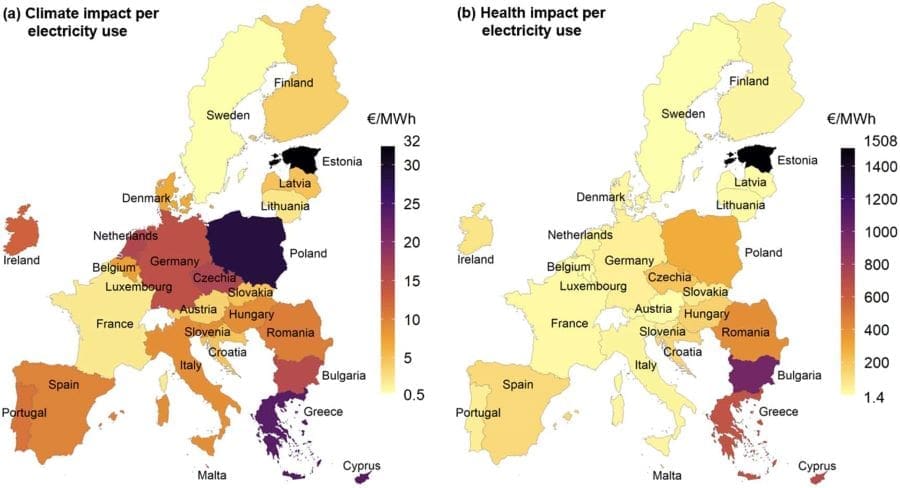Table of Contents
Summary:
Energy efficiency strategies could deliver dramatically greater health benefits in Eastern Europe than in Western Europe, according to a new study published in Environmental Research Letters.
Researchers from Boston University School of Public Health and Harvard T.H. Chan School of Public Health analyzed how energy-related air pollution and greenhouse gas emissions affect both climate and public health across European Union (EU) countries. They found that in regions heavily reliant on coal or oil for electricity – such as Bulgaria, Romania, and Greece – the air pollution health burden can exceed the climate impact by more than tenfold. In Estonia, saving the same amount of electricity can yield over 1,000 times more health benefits than in Sweden. The study highlights wide disparities driven by national energy mixes and emphasizes the need for policies that factor in health impacts alongside climate targets.
EU climate strategies mainly account for carbon emissions, often failing to include the public health harms caused by air pollution from electricity use – including from biomass, which is often grouped with renewables. The team also introduced a tool, CoBE EU, to help policymakers assess the combined health and climate impacts of energy choices, including those from biofuels, which are frequently classified as renewables despite their health risks.

Energy-efficient strategies may produce 10 times more health benefits in Eastern Europe than in Western Europe
The European Climate Law dictates that European Union (EU) countries must reduce harmful greenhouse gas emissions by at least 55 percent by 2030 and become climate neutral by 2050.
In order to achieve this goal, it is imperative that EU countries’ energy policies and strategies quantify both the health and climate impacts of the air pollution generated from electricity use because these burdens vary substantially by country, region, and energy source, according to a new study by Boston University School of Public Health (BUSPH) and Harvard T.H. Chan School of Public Health.
Currently, EU climate policies primarily consider only the climate effects of energy emissions from sectors such as buildings, public transportation, and industry. This approach overlooks the immediate harms that poor air quality is known to have on human health, including increased asthma, lung cancer, and cardiovascular disease.
The new study quantifies these health effects, finding dramatic differences in this health burden from electricity use based on the source of energy that countries use. In places where coal or oil are the main energy source—including in Bulgaria, Romania, and Greece—the air quality-related health burdens can be up to 10 times greater than its climate burden.
“This research is another example among growing data that show how closely related energy choices are to public health,” says study coauthor Dr. Jonathan Buonocore, assistant professor of environmental health at BUSPH. “In the European Union, there would be huge benefits to both health and climate if more renewable energy or energy efficiency strategies were deployed, especially in countries using large amounts of coal.”
The researchers also found that the health benefits of sustainable energy strategies are markedly higher in Eastern Europe than in Western or Northern Europe.
“Saving the same amount of electricity in Estonia can deliver over 1,000 times more health benefits than in Sweden—a striking disparity that highlights the importance of targeted policies,” says study lead author Dr. Gen Pei, research associate in the Department of Environmental Health at Harvard Chan School. “It is important to identify these variations to formulate effective, targeted energy and climate policies in the EU, such as the region-based EU Energy Efficiency Directive and the country-level policies like Spanish Building Technical Code.”
With these findings, the researchers have developed a digital tool called CoBE EU that makes it easier for decision-makers in the EU to gather insight about buildings’ electricity consumption in different countries to understand the benefits of building decarbonization.
“With this open-access online tool, building owners, operators, and policymakers can quantify the climate and health co-benefits of sustainable building development in EU countries,” Dr. Pei says.
For the study, the research team used novel methods to estimate greenhouse gas and air pollutant emissions of energy consumption in the EU. They used the social cost of carbon to estimate the potential monetary impacts of climate change attributed to greenhouse gas emissions from energy consumption, and additional methods to calculate worldwide deaths due to energy emissions in Europe.
Notably, they found that it is critical for countries to distinguish each source that is used for energy consumption to avoid missing sources, such as biofuels, that could be harmful to human health and the environment.
“Biofuels are considered carbon neutral, but have considerable emissions of air pollutants and associated health impacts,” says Dr. Pei. “In countries such as Estonia and Hungary, we found that the relatively high use of biofuels may contribute to their health burdens of electricity use. Energy reports with biofuels lumped into renewables may overlook the potential health burden of air pollution from combusting biofuels.”
This information is also timely as EU countries will need to collectively achieve an additional 11.7-percent reduction in energy consumption by 2030 to meet its climate goal.
“We now have the capabilities to directly integrate public health considerations into energy policy,” Dr. Buonocore says. “Making these external, invisible public health and climate costs visible to energy policymakers can yield massive benefits to public health.”
The study’s senior author is Dr. Joseph Allen, professor of environmental health at Harvard Chan School and director of the Harvard Healthy Buildings Program.
Journal Reference:
Gen Pei, Jonathan J. Buonocore, Parichehr Salimifard, Brian Sousa, Lauren Ferguson and Joseph G. Allen, ‘Assessing the climate and health impacts of energy consumption in European Union countries’, Environmental Research Letters 20, 064027 (2025). DOI: 10.1088/1748-9326/add752
Article Source:
Press Release/Material by Jillian McKoy | Boston University School of Public Health
Featured image credit: jannoon028 | Freepik




